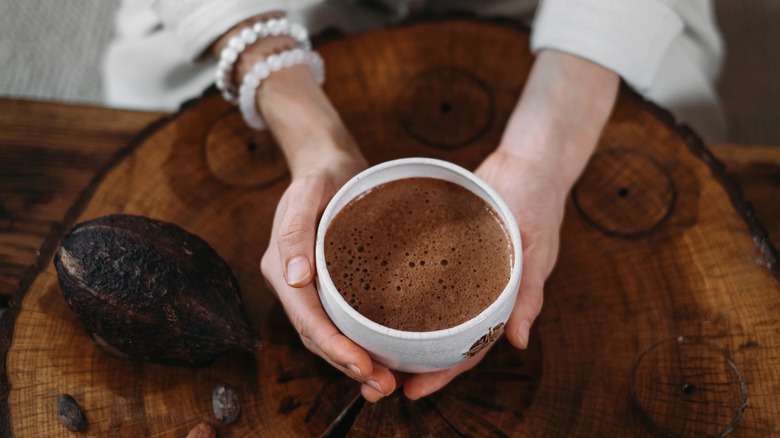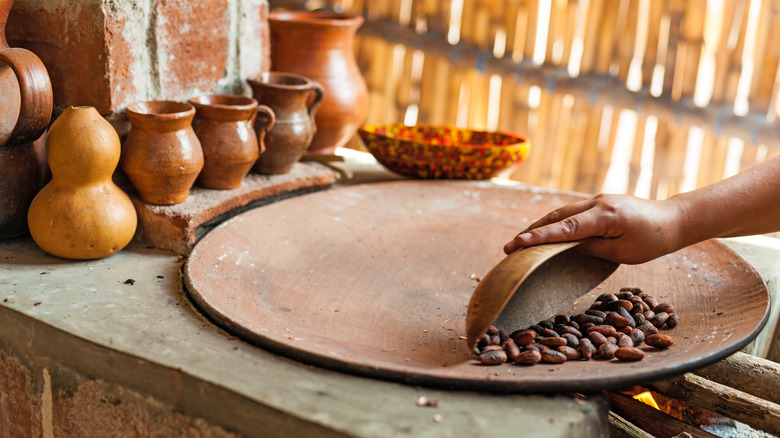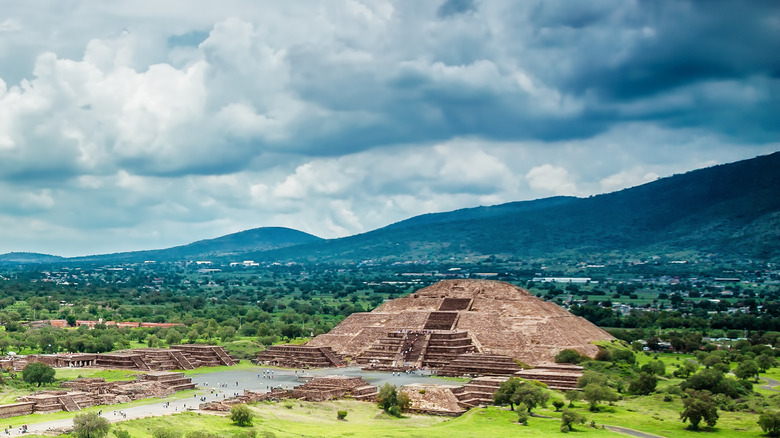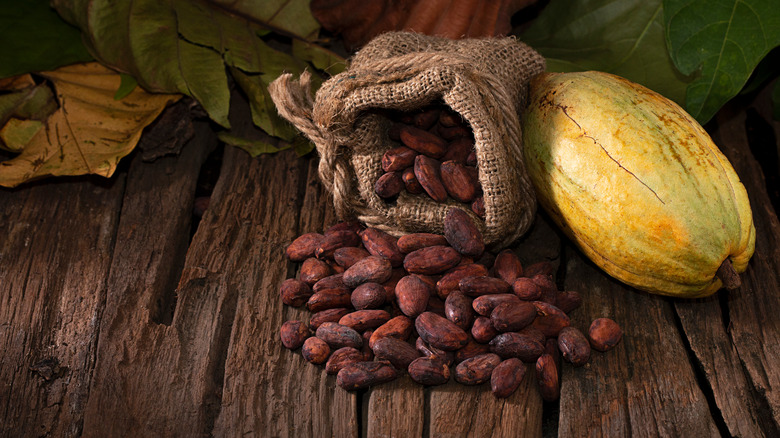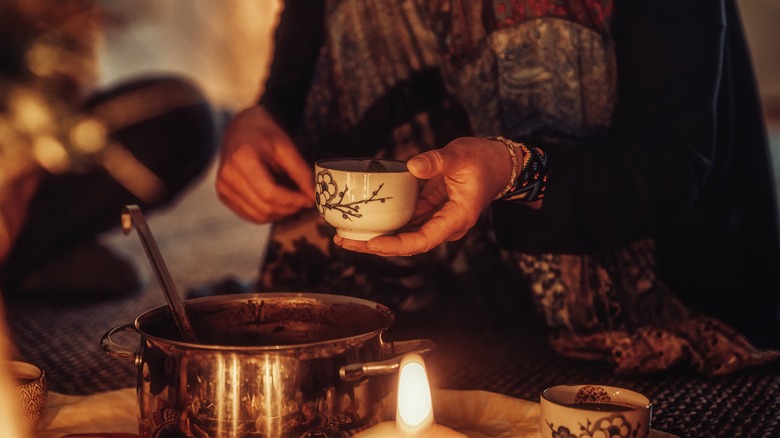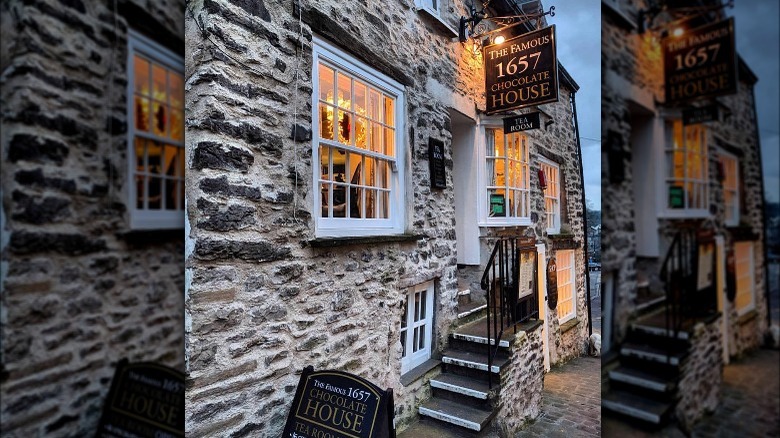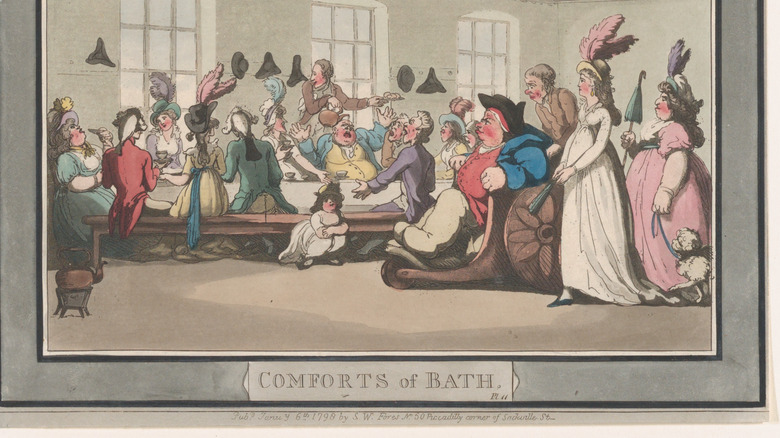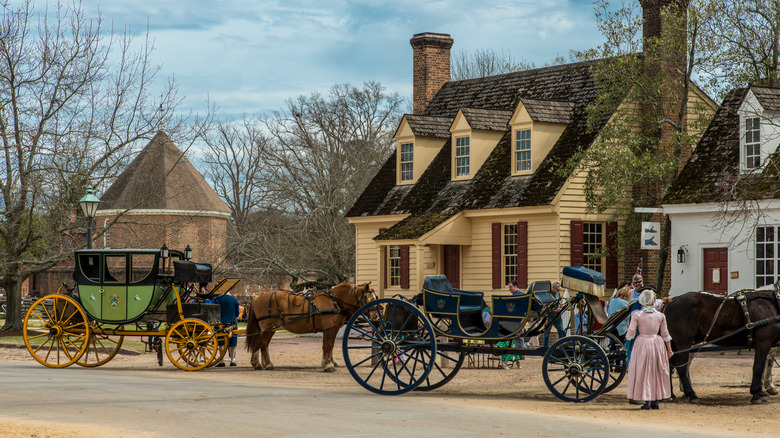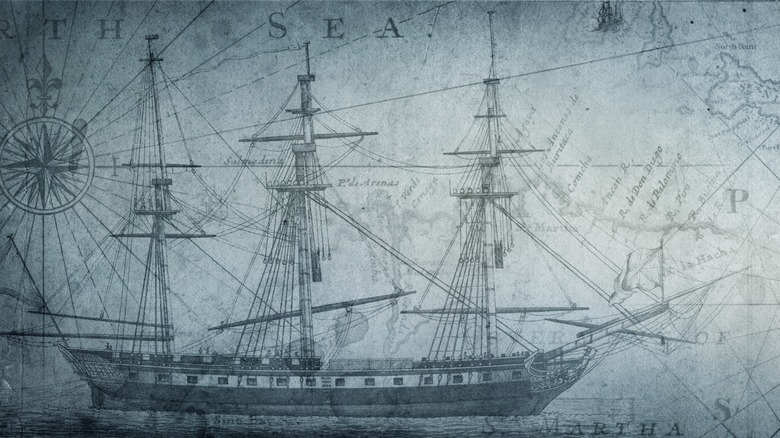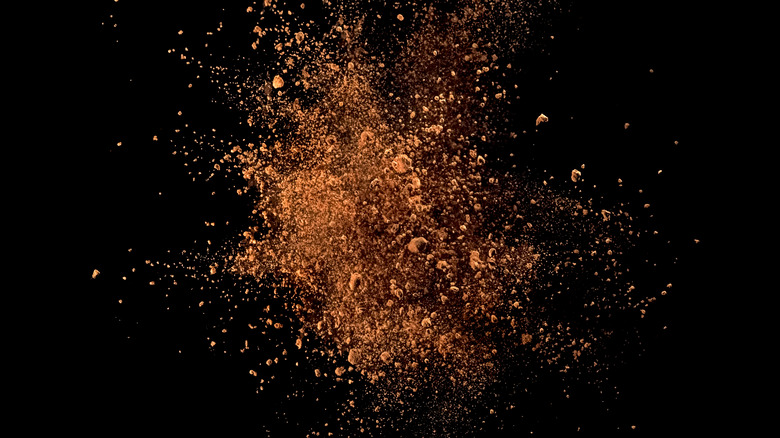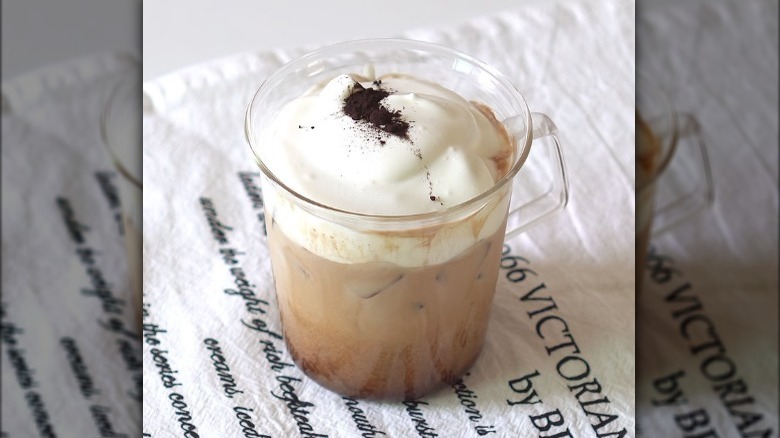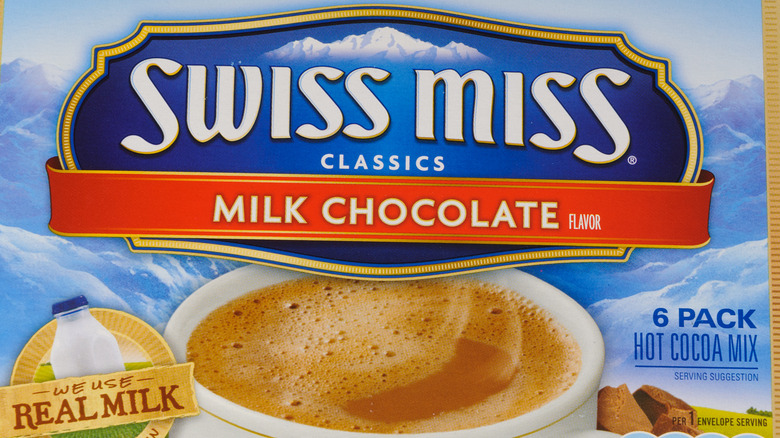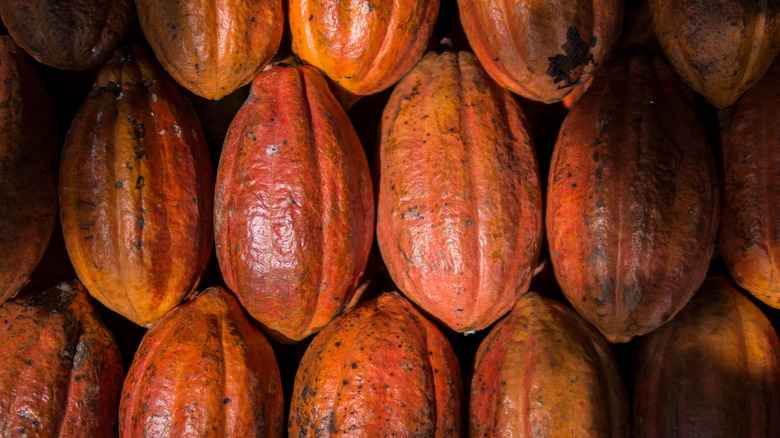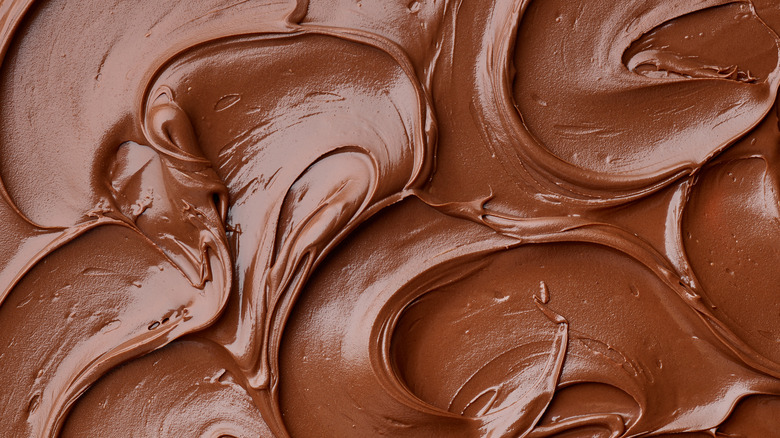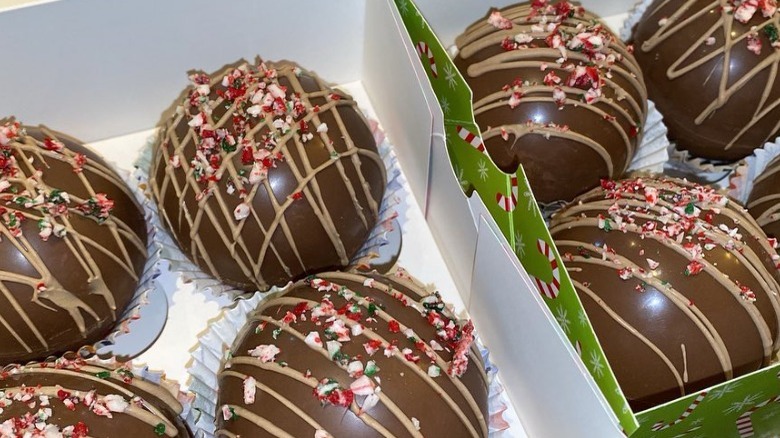The Untold Truth Of Hot Chocolate
It's a given: Blustery days are not best met with coffee or tea, but rather a rich, steamy cup of cocoa. There's just something about the way that hot chocolate so pleasantly sits in the stomach and warms up the soul that perfectly combats those otherwise unbearably cold days. So well-loved is hot chocolate that, according to the cookbook "Dining with the Washingtons" (via NPR), George Washington himself preferred to start his mornings with a mug of it.
Hot chocolate's place in American cuisine persists to this day. Even some two centuries later, sipping hot chocolate remains a favorite winter pastime for many (via Study Finds). The featured study also notes that the love for hot chocolate remains not necessarily limited to the season: About 43% of interviewees believed that the warm drink need not be limited to the coldest season of the year. Despite the indifference to warm or cold weather, many prefer nonetheless to keep their hot chocolate "traditional," according to the study. But, what exactly does it mean to have a traditional cup of cocoa? That depends largely on whom you ask and when. After all, hot chocolate is truly both a marvel of history and geography alike.
Hot chocolate got its start in the Americas
People have Mesoamerica to thank for the initial cultivation of cacao, which is the main ingredient in chocolate-making. Smithsonian Magazine specifically credits the first cultivation of chocolate to the Olmec civilization, which is reported to have used cacao as early as 1500 B.C. The cultivation and preparation of chocolate spread throughout Mesoamerica and was adapted by empires such as the Maya. Interesting to note, however, is that cacao beans were just about exclusively consumed in liquid form for thousands of years (via NPR). With no means of refining the chocolate into the smooth texture we know today, these civilizations primarily fermented and consumed it as a drink. So in the question of the chicken or the egg, it can be definitely said that the cup of chocolate came first.
The drink was known to the other Mesoamerican and South American cultures as chocolhaa or xocolatl, which roughly translates to "bitter water" (via Inter-American Foundation). This aptly refers to the drink's taste, as there were no sugars available to the region and no means to mellow out cacao's harshness. Instead, the cacao was often flavored with vanilla, chili, or even magnolia (via Smithsonian Magazine). Similar to beer or coffee, this ancient hot chocolate was celebrated and revered. The magazine notes that cacao was served frothy and was a very important part in cultural, religious, and social life.
Hot chocolate was especially treasured by different cultures
The Inter-American Foundation observes that drinking chocolate was important to many cultures in Mesoamerica. Beyond being a drink to enjoy, chocolate came to take on various meanings for different cultures. For example, both the Mayans and Aztecs viewed cacao as a gift directly from the gods to humans: It was a cornerstone in important harvest and funeral traditions. Aztecs saw cacao beans as "more valuable than gold" and even used them as a form of currency (via History).
Possibly due to its perception as a gift from the gods, chocolate was ubiquitous in Mayan culture. It was used to celebrate as well as to mark the end of essential transactions (sort of in the way champagne is used today). But it was also kept at home to enjoy in the everyday. Interesting to note is that frozen hot chocolate may not be as newfangled as it appears. Mayans served their chocolate drinks warm or cold, per History.
Spanish colonization (and pirates) introduced Europe to hot chocolate
In 1519, the Spanish conquistador Hernán Cortés arrived in the Americas. It wasn't long before he and his team learned about cacao and drinking chocolate, according to the Alimentarium. Cortés was, as observed by the food and nutrition museum, aware of the potential chocolate would have back home. In 1528, the colonizer returned with cacao beans and the tools needed to make them into a drink. While the monarchy didn't initially take to the beverage, the country became smitten with the drink by the 1600s once sugar was added. As Atlas Obscura notes, the Spanish would consume chocolate only in liquid form at this point.
In the 1630s or 1640s, the botanist-gardener-turned-pirate William Hughes reached the Americas and later shared with the Anglophone world his notes on drinking chocolate (via Atlas Obscura). There had been secondhand accounts, and even reports from Christopher Columbus, but Hughes was the first to bring back detailed instructions on hot chocolate preparation. At this point hot chocolate was mixed with milk, maize, sugar, and even nutmeg or ambergris to sweeten the pot. As the century persisted, according to the Alimentarium, a proper "chocomania" had kicked in and arguably persists to this day.
Women made a lot of the hot chocolate
History might better remember the men centered around chocolate, but it was largely women who played a heavy hand in its production. While it remains unclear what role women played in European hot-chocolate production, the role that Mesoamerican women exercised cannot be ignored. So important were women in the Americas that the Indiana University East campus library blog described them as intrinsic to the drink. According to the blog, women were responsible for the preparation of hot chocolate, both for everyday use and rituals. Women were also the keepers, in certain cases, of special chocolate recipes. As the university notes, drinking chocolate could vary. In some cases the chocolate was intended as an everyday drink. Other times it was considered an offering "to appease household gods." Chocolate drinks were also prepared as a kind of homemade spell or even love brew to entice suitors.
Atlas Obscura goes so far to describe drinking chocolate as a "vehicle" for spells. Maybe drinking chocolate became popular for witchcraft because of how often and fervently it was enjoyed. Or perhaps, the magic of chocolate, which was considered a gift from the gods, added to the potency of the spell. It's all speculation. Unfortunately, because of the role of spell-making in chocolate drinks, some women were persecuted as witches and brutally murdered as a result.
Hot chocolate was a luxury good in Europe
While hot chocolate may have been available on the street in countries like Spain, it remained an expensive drink compared to other imports like coffee or tea (via Alimentarium). When England started importing chocolate in the second half of the 17th century, it was especially expensive due to the heavy import taxes surrounding it (via Cadbury). As a result, drinking chocolate became a treat reserved for the extremely wealthy or for clergy.
As Cocoa Runners notes, French nobility in particular was fond of making hot chocolate. According to Cadbury, before marrying King Louis XIV, Maria Theresa of Austria was a Spanish princess who gifted her husband, Louis XIV, with chocolate for their wedding. Louis even appointed a royal chocolatier to make hot chocolate with the monarch's stamp on it.
Outside of the royal court, chocolate houses began to spring up, allowing those who had enough money to indulge in a hot cup. As noted by Cocoa Runners, chocolate houses were swashbuckling places where unruliness and misadventure ruled. Spiced and frothy cups of hot chocolate were served to gamblers and thinkers and rabble-rousers alike. One chocolate house even had a tunnel to sneak out smugglers and the like. What a salacious tale for such a sweet treat!
Chocolate was also prized as a medicinal drink
Drinking chocolate was long believed to have therapeutic properties in Mesoamerica (via Alimentarium). As the museum explains, Aztecs in particular heralded the drink as both "fortifying and aphrodisiac" in nature. Cocoa butter was even used as a sort of salve to treat wounds.
The University of Huddersfield points out that the Aztecs specifically held hot chocolate in high regard for its medicinal properties. The drink was considered as a sort of cure-all for illnesses and maladies. One friar in Mexico reported that hot chocolate could even be effective in treating kidney disease (via National Library of Medicine).
Meanwhile, as hot chocolate made its way to Europe, it was met with caution. The European Church initially feared the effects of drinking chocolate. As the Alimentarium notes, at one time, it was even considered improper for children to drink hot chocolate. But doctors advocated for the use of hot chocolate as a therapeutic substance. Hot chocolates were even later used as a means of masking more bitter medicine, per the library. The debate ultimately gave way, with the drink certainly being kid-friendly today.
Hot chocolate came stateside in the 18th century
It's no surprise that hot chocolate played a role in colonial America as well. The blustery winters of large swaths of the original 13 colonies sure did need some sort of warming up. As noted by NPR, hot chocolate really took off and not just with the well-established. Hot chocolate was much more affordable in colonial times. This is due particularly to the proximity of the colonies to cacao and sugar-growing regions, which drastically reduced the price of the drink. It's also worth noting that hot chocolate wasn't just reserved for the breakfast table. It was often used as a sort of high-energy drink to be consumed in times of fatigue or when in need of a boost.
Smithsonian Magazine observes that hot chocolate was a much more common treat in the colonies than it ever was overseas at this period of time, though it was still vastly different from the hot chocolate that we enjoy today. It was, per the magazine, a thicker brew that was much less sweet and much more cacao-heavy in taste. Also important to note is that cocoa powder had not yet been invented. So, every hot chocolate that was served was indeed a melted chocolate.
The drink also gained favor among sailors
Hot chocolate may not seem like the drink of choice for rough-and-tumble sailors. But, as history shows, hot chocolate was turned to time and time again in battle. In fact, even in Mesoamerican society, drinking chocolate was considered fuel for warriors, according to Gear Patrol.
The history of U.S. soldiers drinking hot chocolate dates as far back as the American Revolution (via Valorous TV). Colonels at that time were issued cacao rations, and nearly a century later soldiers in the Civil War would receive hot chocolate when injured to help calm their nerves. Cacao rations were considered an especially important element in World Wars I and II, maintaining morale and soothing those in times of need.
According to the U.S. Constitution Museum, hot chocolate was especially popular among sailors, who received the drink at an extremely low price from the U.S. Navy. Interesting to note is that sailors mostly served their hot chocolate up frothy, according to various recipe books. While it's not quite clear why exactly the sailors were the ones who received the cacao discount, it is safe to assume that the warm cup of chocolate probably made for welcome company on the open sea.
In the 19th century, hot cocoa came to be
Drinking chocolate of the past didn't quite resemble the hot cocoa of today (via Smithsonian Magazine). The hot chocolate of yesteryears was much thicker and more chocolatey in flavor, due primarily to the fact that it was made directly from melted chocolate. Simply put, the cocoa powder that is commonplace today did not exist for a very long time.
In fact, it wasn't until 1828 that the first cocoa powder would be developed, according to Inaforesta. The Joy of Baking defines cocoa powder as a substance made from cacao beans that have had an overwhelming majority of the cocoa butter removed. The solids are then dried and processed into powder, which can then be sweetened and made into the hot cocoa that we know and love.
But, the invention of cocoa powder didn't just revolutionize the way that hot chocolate is made and tastes. It also made hot chocolate accessible to the masses (via History). The cocoa press and ability to turn cocoa into a powder made it exceedingly cheap. The dawn of a sweeter, smoother hot chocolate was upon the world.
The mocha coffee was modernized in the U.S.
Leave it to the U.S. to approach hot cocoa with a keen sense of innovation and ingenuity. Mocha coffee has its roots in a few different places, according to Waka Coffee & Tea. As the coffee makers note, the name "mocha" refers to the city of Al Moka in Yemen. The coffee beans from around this region reportedly had natural notes of chocolate to them.
Today's mocha coffee, also known as caffè mocha, takes its inspiration from bicerin, a drink that evolved in a café in Turin, Italy. The caffè mocha and bicerin are strikingly similar in construction: both use espresso, cream, and chocolate. The latter drink, however, comes deconstructed, leaving consumers with the responsibility of stirring the drink's separate layers to their heart's content. The former is said to have first appeared in a recipe in 1892. Given that cocoa powder was first developed in 1828, according to Inaforesta, it can be inferred that its development helped in the creation of the caffè mocha. Worth noting is that mocha coffee can also be made with either espresso or regular coffee (via Waka Coffee & Tea).
By the 1950s, the first instant hot chocolate was invented
Sanna Dairy Engineers had a contract to supply troops in the Korean War with powdered creamer, but once the war ended, the company found itself with a surplus (via Smithsonian Magazine). With the war over and the creamer no longer needed, the company had a lot of product on its hands to unload. The innovative CEO, Charles Sanna, turned the not-so proverbial lemons into lemonade and got to work on what would essentially launch the instant hot chocolate industry.
Sanna experimented to find the perfect combination of powdered creamer, cocoa powder, and sweetener to make a cocoa mix. According to Pop Icon, the instant cocoa mix was initially sold exclusively to restaurants and airlines during the 1950s. It was common for people to purloin the individually served packets. Sanna quickly realized the potential for the instant hot cocoa, and by 1961 the hot cocoa mix hit the grocery stores under the name Swiss Miss. The recipe was slightly adjusted to include non-fat creamer to extend the product's shelf life (via Smithsonian Magazine). Not only did Swiss Miss usher in the dawn of instant cocoa, but it marked a turning point in the long history of hot chocolate.
Hot chocolate may still have health benefits
Despite all the iterations of hot chocolate over the years, its health benefits remain, at least in certain circumstances. A 2009 study from the International Journal of Molecular Sciences notes that cacao powder is rich in antioxidants that can fight inflammation and help improve blood pressure and cholesterol levels. Unsurprisingly, cacao has also been shown to have mood-boosting properties.
Not-so-healthy hot chocolate is less about the cacao and more about the drink's other ingredients, such as milk, sugar, and the like. While the names are startlingly similar, there are some key differences between cacao and cocoa. Cacao mixes tend to have a higher percentage of healthful cacao as well as an abundance of minerals like calcium and potassium (via Ritual Cacao) Instant cocoa tends to be loaded with artificial sweeteners and powdered milks. In addition, it loses some of its nutritional value when processed at high heat for the conversion into a powder. Ritual Cacao's site suggests cacao as the healthier option to get the most out of your warm and comforting cup of hot chocolate.
Hot chocolate is a big American market with projected global growth
To this day, hot chocolate persists as a beloved drink. Look no further than the statistics. According to a 2021 report from Market Research, hot chocolate remains well-stocked in American households. The report notes that the drink is so popular in fact that the industry experiences very little change in demand in either direction. It simply is. The report does predict, however, that as disposable income grows in the U.S., the hot cocoa industry will also grow. The report suggests that Americans have a growing taste (and demand) for refined chocolate. So, perhaps the next chapter for hot chocolate is one of gourmet, sustainably harvested hot cocoa blends. The report also predicts that more health-oriented cocoas, like those that are sourced from a dark chocolate or are low on sugars, will become mainstays on the market.
PR Newswire reports that the hot-chocolate industry is also experiencing growth on the global scale. Running parallel to the domestic market, the global hot-chocolate industry is expected to grow as disposable incomes grow, and the middle class expands. Interestingly, there is a call on the international level for a healthier hot chocolate. It seems as if the world is on the cusp of a hot chocolate that can serve people in a healthier, more sustainable way.
Hot chocolate bombs are a new take on an old favorite
In 2019, Eric Torres-Garcia posted a TikTok of what would later become known as the Cocoa Bomb. The TikTok featured hot milk being poured over a glob of chocolate, which popped opened to reveal marshmallows and create the hot chocolate. He didn't create the first hot chocolate bomb – Oprah's Favorite Things in 2018 recommended one shaped like a snowman. But Torres-Garcia certainly gave the treat a boost.
As noted by Boise State News, his hot chocolate bombs were a viral hit. As of September 2022, that TikTok has garnered 2.6 million views. The bomb created by the Boise State University graduate was quite literally an overnight sensation. Garcia received $6,000 worth of orders the day his video posted. Impressively enough, that TikTok was also Garcia's first crack at the bomb. Talk about striking gold!
According to the publication, Garcia drew inspiration from his time abroad and was specifically inspired by the Italian Kinder Egg candy with a toy inside it. Garcia had an American audience in mind, however, and sought to keep edible insides for the bombs so that they could be sold in the states. With $100,000 in revenue from the first year and a deal with Kroger, it could be that hot chocolate bombs are here to stay! They certainly make for a wonderful experience when creating to a frothy cup of cocoa. For those daring bakers, why not try out a homemade hot chocolate bomb?
